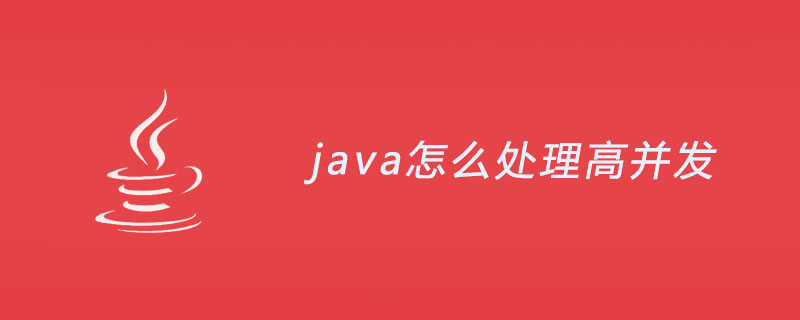
How to deal with high concurrency in java: 1. Optimize code and reduce unnecessary waste of resources; 2. Separate pictures from pages and put pictures into independent picture servers; 3. Use cache, you can Significantly reduce the interaction with the database and improve performance; 4. Use database clusters; 5. Perform DB optimization; 6. Achieve load balancing on the hardware, etc.

Java's method of handling high concurrency:
1. Start from the most basic place and optimize what we write code to reduce unnecessary waste of resources.
a. Avoid frequent use of new objects. For classes that only need one instance for the entire application, we can use the singleton mode. For String connection operations, use StringBuffer or StringBuilder, which can be accessed through static methods for tool classes.
b. Avoid using the wrong method and try not to use instanceof for conditional judgment. Use efficient classes in Java, such as ArrayList, which has better performance than Vector.
Video Course Recommendation →: "Ten Million Level Data Concurrency Solution (Theory and Practical Combat)"
2. HTML static
We access through a link address. Through this link address, the corresponding module of the server processes the request, goes to the corresponding jsp page, and finally generates the data we want. However, if there are tens of millions of requests and there are too many high concurrent requests, it will increase the pressure on the server, and in the worst case, the server will be brought down. So how to avoid this situation? If we save the result of the initial request for test.do into an html file, and then the user accesses this html file every time, so that there is no need to access the server anymore, wouldn't the pressure on the server be reduced?
How to automatically generate a static page? When a user visits it, test.html will be automatically generated and then displayed to the user.
3. Image server separation
For web servers, images consume the most resources, so it is necessary for us to separate images from pages. We put images on an independent image server. . Such an architecture can reduce the pressure on the server system that provides page access requests, and can ensure that the system will not crash due to image problems. On the image server, we can optimize different configurations.
4. Use cache
Try to use cache, including user cache, information cache, etc. Spending more memory for caching can greatly reduce the interaction with the database and improve performance.
5. Batch transmission
When I was working on a certain project, too many parameters were transmitted at one time, and the database stipulated that the maximum number of parameters that could be transmitted at one time was 30,000. At that time, there were 50,000 parameters. Record, how to send it? In the end, it is sent in batches. If the elevator cannot fit so many people at one time, it will report an overweight bug, so people will be sent up in batches.
Another time in the examination system, if so many examinees submitted to the database at the same time, the pressure on the database would increase and sometimes it would be down. The method used at that time was to use ajax asynchronous transmission without waiting. When the candidate clicks the submit button, the candidate's answers are automatically submitted. This also avoids the loss of the questions that the candidate has done before when there is a sudden power outage.
6. Database cluster
When faced with complex applications and a large number of users accessing them, one data set will soon be unable to meet the demand, so we need to use a database cluster or database table hashing.
We install business and application or functional modules in the application to separate the data. Different modules correspond to different databases or tables, and then disperse a certain page or function into smaller databases according to a certain strategy. List.
7. DB Optimization
a. When designing the database, we must consider later maintenance. The three paradigms of the database are the principles we must follow when designing the database.
b. Index creation: Index creation must be appropriate. If a table is often queried and rarely used for additions and modifications, we can create an index for this table because it is not used for additions and modifications. and deletion operations, our maintenance of the index greatly exceeds the efficiency that the index brings to us.
c. The type selection of table fields should appropriately include the length, type, etc. of the fields. The selection should be based on the actual stored data. The length should not be too long, otherwise it will affect efficiency.
d. Foreign keys should be used with caution, because the primary key represents this table, and the foreign key represents a group of tables, which associates the tables. We need to associate them when deleting, modifying, etc.
e. In database operations
Try to use prepareStatement and use Statement less, because PrepareStatement is precompiled.
Connection is set to readOnly. Connection is a connection to the library and is heavyweight. We can just use it.
Using the connection pool, we can modify the default number of connections in the database.
8. Achieve load balancing on hardware
The above is the detailed content of How does java handle high concurrency?. For more information, please follow other related articles on the PHP Chinese website!